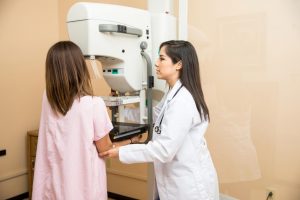What is intraductal papilloma? Intraductal papilloma (papillary cystadenomas, cystadenopapillomas) is a benign papillary outgrowth arising from the epithelium of the ducts of the mammary gland. They can develop at any age — from puberty to postmenopause. The frequency of detection of cystadenopapillus in mammology is about 10% among the total number of tumor-like diseases of the breast.
Macroscopically, the intraductal papilloma of the mammary gland resembles a cystic mass with nipple growths. Papillomas are easily injured, and the bloody fluid released during this process enters the excretory ducts and is excreted out of the nipple. Hemorrhages and necrosis are possible in the area of the tumor; multiple intraductal papillomas of the mammary gland are often malignant.
![2734357_detail[1]](https://papillomas.org/wp-content/uploads/2019/10/2734357_detail1-300x200.jpg)
Contents
- What Intraductal Breast Papillomas Are Distinguished?
- What Are the Causes of Intraductal Papillomas?
- What Symptoms of Intraductal Papillomas May You Notice?
- Intraductal Papilloma vs Carcinoma
- How to Be Sure You Have an Intraductal Papilloma?
- Are There Risks to Have Intraductal Papilloma Cancer?
- How Is the Intraductal Papilloma Surgery Performed?
- What Papilloma Intraductal Preventive Measures Should You Take?
What Intraductal Breast Papillomas Are Distinguished?
Papillary cystadenomas of the mammary gland can develop in any part of the ductal system — from the nipple to the terminal duct-lobular structural units. Based on localization, central ![11447tn[1]](https://papillomas.org/wp-content/uploads/2019/10/11447tn1-300x226.jpg) papillomas, located in the areola area, and peripheral are distinguished. Despite the fact that in many cases, papillomas are benign, there may be atypical intraductal papilloma, which has the atypical cellular proliferation.
papillomas, located in the areola area, and peripheral are distinguished. Despite the fact that in many cases, papillomas are benign, there may be atypical intraductal papilloma, which has the atypical cellular proliferation.
Intraductal papilloma of breast can be single (solitary) and multiple; their sizes vary from a few millimeters to 1-2 cm in diameter. Solitary papillary tumors are more often localized in the subareolar region; multiple — closer to the periphery of the gland.
Multiple intraductal papilloma of the mammary gland is characterized by a high potential possibility of malignancy. As a rule, intraductal papilloma with atypia, intracystic or intraductal papillary breast cancer arises from the factors mentioned above.
What Are the Causes of Intraductal Papillomas?
What causes intraductal papilloma? The determining factor leading to the development of intraductal papilloma pathology outlines is hormonal imbalance. The development of intraductal papilloma of the mammary gland can be triggered by any changes in hormonal homeostasis: ovarian dysfunction, oophoritis, adnexitis, abortions, obesity, stress, etc. Women at risk for developing intraductal papilloma of the mammary gland are nonsmoking, smokers. To a lesser extent the development of breast tumors are susceptible to patients with children who are breastfed, using hormonal contraception.
As a rule, intraductal papilloma causes include the development of papillary cystadenomas against the background of the existing fibrocystic (nodular or diffuse) mastopathy. As a result of mastopathy, a local expansion of the mammary gland ducts occurs, in which papillary growths occur. In patients with sclerosing intraductal papilloma, a family history of tumor lesions of the mammary glands of a malignant or benign nature is often traced.
What Symptoms of Intraductal Papillomas May You Notice?
The first clinical intraductal papilloma symptoms include the appearance of heavy discharge from the nipple of a different nature. Check intraductal papilloma images to know how they look like. There may be a green breast discharge intraductal papilloma. The discharge may be clear, whitish, greenish, brown, or bloody.
The breast intraductal papilloma can be felt when it is located in the main duct. In this case, palpation in the area of the areola felt a rounded knot of elastic consistency, slightly painful when it is pressed. Squeezing the nodule is accompanied by the release of bloody drops from the nipple and a decrease in the tumor. With the development of secondary inflammation, intraductal papillomas symptoms change: the tumor node becomes denser, swelling of the surrounding tissues develops.
![B9781416056829501578_fx1[1]](https://papillomas.org/wp-content/uploads/2019/10/B9781416056829501578_fx11-300x145.jpg)
Intraductal Papilloma vs Carcinoma
Carcinoma is a type of malignant neoplasm that develops from epithelial cells. The most common areas of carcinoma localization are the surface of the skin (basal cell carcinoma), the vagina (vaginal cancer, cervical cancer), liver, stomach, and the mammary gland.
Statistics of modern cancer indicates a disappointing increase in the incidence of malignant breast tumors. According to the WHO, this type of oncology has a proven hereditary predisposition, but about 68% of the patients who applied did not have diagnosed carcinoma of the breast in two generations for both parents. This cancer is called sporadic and is caused by a number of external causes. Compared to the malignant intraductal papilloma, the chances to save the female breast are higher if being diagnosed with carcinoma.
![Fig-4-15-Intraduct-papillary-lesions[1]](https://papillomas.org/wp-content/uploads/2019/10/Fig-4-15-Intraduct-papillary-lesions1-300x212.jpg)
How to Be Sure You Have an Intraductal Papilloma?
In the diagnosis of intraductal papilloma of the intraductal papilloma with apocrine metaplasia , the doctor focuses on the symptoms of the disease (discharge from the nipple) and the data of examination and palpation. When palpating, an elastic nodule of a round shape can be found in the area of the areola, slightly painful when pressed. Squeezing the node leads to the release of blood drops from the nipple, while the size of the tumor is reduced.
To clarify the diagnosis, intraductal papilloma pictures aren’t enough. The following studies are performed before the intraductal papilloma removal:
- mammography,
- ductography (contrast radiography of the milky ducts);
- intraductal papilloma ultrasound ;
- cytological analysis of smears from the nipple;
- a blood test for breast cancer tumor markers;
- MRI
Conducting an ultrasound, mammography and MRI of the mammary gland does not allow to examine the milky ducts but it helps to differentiate the intraductal papilloma from breast cancer. Also, in the process of diagnosis, it is necessary to exclude galactorrhea that occurs during prolactinoma.
Are There Risks to Have Intraductal Papilloma Cancer?
Is intraductal papilloma cancer ?Intraductal papilloma (intraductal papilloma, Mintz disease, Schimelbush disease) is a benign epithelial tumor, which is located in the lumen of the milky duct of the breast. It is more common in women whose age is about 35-45 years. Intraductal papilloma can be single or multiple. A single growth has a benign course.
What is intraductal papilloma prognosis? Multiple formations have a relatively high tendency to scorch. It should also be said that papillomas, which are located in the peripheral parts of the mammary gland, have a high risk of malignancy. Tumor sizes can be variable, from a few millimeters to several centimeters. Proceed from the epithelium of the milky ducts, can have both narrow and wide base. Morphologically, they are practically no different in structure from ordinary papillomas.
Given the intraductal papilloma cancer risk, surgical treatment is recommended, which consists in performing sectoral resection of the gland together with a growth. When the process of malignancy starts- treatment tactics should be chosen in accordance with the principles of treatment of breast cancer. Not very noticeable, but rather a dangerous female disease — intraductal papilloma of the mammary gland — has other names: cystadenopapilloma, papillary cystadenoma. Multiple symptoms of intraductal papilloma are particularly dangerous, which over time can transform into intraductal or intracystic breast cancer, which is why it is necessary to diagnose a disease that is harmless in appearance as early as possible and prescribe surgery to remove intraductal papilloma.
How Is the Intraductal Papilloma Surgery Performed?
Since intraductal papilloma refers to precancerous lesions of the mammary gland, only surgical intraductal papilloma treatment is prescribed. Such papillomas rarely disappear on their own, moreover, they are dangerous inflammatory complications and the development of malignant tumors. The intraductal papilloma management is performed under general intravenous anesthesia. If intraductal papilloma icd 10 is located in the central region of the breast, the nipple is retained. In the peripheral areas, intraductal papilloma excision is usually performed. In case of papillary cystadenoma, a sectoral resection of the mammary gland is performed, during which tissues with altered ducts are removed.
Usually, the surgery for intraductal papilloma is performed through a periareolar incision, which further does not affect the size and shape of the breast and eliminates the need for mammoplasty. If an intraductal papillary cancer is detected, the only treatment for intraductal papilloma is the radical mastectomy. Intraductal papilloma surgery recovery period depends on the type of the procedure. During the intraductal papilloma surgery recovery time, you should follow the recommendations of your doctor concerning the intraductal papilloma emedicine, which will include pain killers, and the choice of the suitable bra.

What Papilloma Intraductal Preventive Measures Should You Take?
To prevent the development of intraductal papilloma breast and avoid the surgical removal of intraductal papilloma, it is possible with the help of the regular mammology examination, timely treatment of mastitis, inflammatory and dyshormonal disorders of the female genital tract. For the early detection of tumor changes, systematic self-control is recommended, including palpation examination of the mammary glands. The main measure of prevention is a careful attitude of a woman to her health. The following activities are required:
- regular examination by a gynecologist;
- After 35 years of age, mammography needs to be performed regularly;
- timely treatment of pelvic inflammatory diseases, as well as dyshormonal diseases;
- self-examination of the mammary glands for the early detection of any tumors;
- giving up bad habits (especially smoking).
It is noted that the incidence of intraductal papilloma of the mammary gland and some other tumors of the female genital area is markedly reduced in women who have given birth and breastfed.
